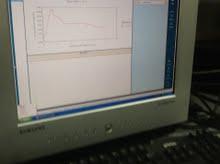Composite Materials lab
Jason Rann and Charisse Nelson
Jason devoted week 5 on completing the optical microscopy of the AZ91 T4 and T6 heat treated specimens. There are inherent disadvantages to using an optical microscope though. First, there is a limit to the magnification based on the large wavelength of visible light in comparison to other light wavelengths and the wavelengths of electrons. Secondly, optical microscopes do not clearly show depth at high magnification. Because of these disadvantages of the optical microscope, Jason chose to image the specimens with an electron microscope as well.
The images were captured using the Back Scattered Electron mode which fires electrons with a high potential at the specimen. These electrons interact with the specimen and then are redirected toward a detector. The main purpose was to track precipitate migration during the heat treatments. As a heat treatment is applied, the precipitate’s migration is sped up. The microscopy shows evidence in two ways, change of size and amount of precipitates and the presence of a eutectic mixture, which is an area surrounding and connecting the precipitates that is evidence of migration. The T4 specimen showed evidence of smaller precipitates and a smaller amount. The T6 specimen showed the eutectic mixture. This optical and electron microscopy data will be correlated with hardness testing data taken in previous weeks to determine how the strength of the alloy changes when exposed to different heat treatments.
After completing Strain Rate Sensitivity for all 54 of her samples, Charisse turned the data from the tests into Stress-Strain graphs. The purpose of these graphs is to show the amount of force (or stress), it takes to change the sample length (or strain), over a given amount of time, i.e, strain rate. Three different strain rates were applied: 0.0001 s-1, 0.001 s-1, and 0.01s-1, which corresponded to the longest tests lasting over an hour and 45 minutes and the shortest test done in less than 5 minutes. The peak point on the graph represents the point where the sample has become deformed and can no longer retain its originally elastic state. After finishing the analysis of the stress-strain graphs for all the samples, Charisse will be able to tell what effect density of microballoons and strain rate have on the different syntactic foams she created.
